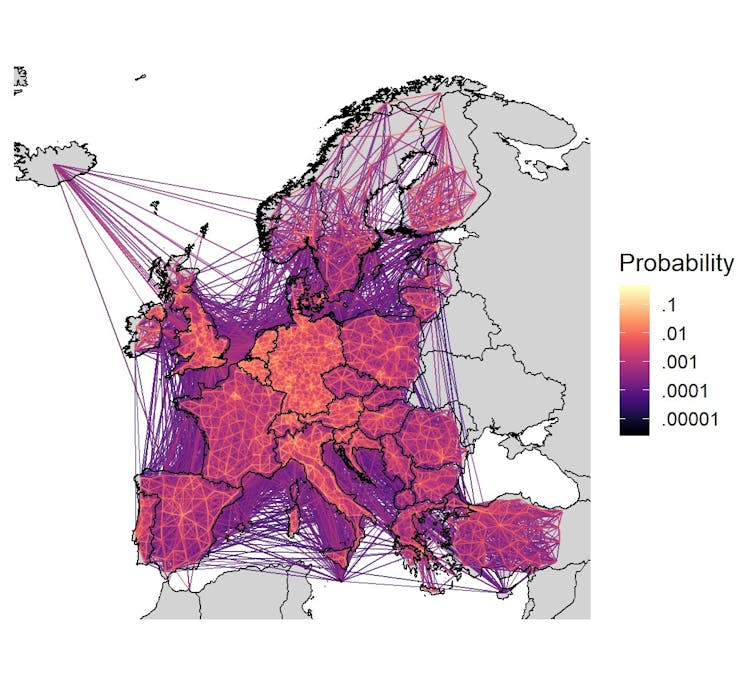Please help us improve PreventionWeb by taking this brief survey. Your input will allow us to better serve the needs of the DRR community.
Coronavirus variant: Europe needs to coordinate lockdowns now to control it
By Andrew J Tatem and Nick Ruktanonchai
With the advent of winter and the emergence of a new variant of the SARS-CoV-2 virus, cases of COVID-19 have been rising sharply in many countries and governments are scrambling to keep up. As vaccines slowly roll out around the continent, governments are introducing lockdowns, curfews and border closures to try to keep cases under control.
Since the pandemic began, governments have struggled to strike an effective balance between restoring economic activity and preventing large outbreaks of COVID-19.
For affected countries, the difference between the widespread community transmission that we are seeing now, and more localised outbreaks such as those we saw in summer, will depend on both controlling local transmission and preventing cases being imported to places with lower rates of COVID-19.
This becomes especially important when different countries reduce mobility to different degrees in response to the pandemic.
Not all “lockdowns” are the same and, as European countries move in and out of periods with increased restrictions, travel from nearby areas can threaten to quickly reverse any progress in reducing COVID-19 cases. The virus does not respect national borders.
Instead, our research shows that coordinating restrictions across countries is a much more effective way of controlling the spread of coronavirus.
Tracking outbreaks with real-time data
For strongly connected areas, such as the countries of Europe or the states of the US, preventing outbreaks means working out where new cases are most likely to come from, and whether border restrictions and social distancing measures can be coordinated with neighbours.
Knowing this is difficult, particularly in a rapidly changing situation such as the COVID-19 pandemic. Community response to the pandemic and continuing control efforts mean travel patterns can change dramatically based on perceived risk and local interventions, and these must be accounted for when quantifying potential outbreak risk and the lifting of restrictions.
With increasing numbers of us carrying smartphones, anonymised and aggregated location history data from them mean that scientists can begin to address such issues in near real-time. We can use this information to predict where outbreaks are likely to spread next, how much people have reduced their travel, and where super-spreading events may occur.
Paired with simulations of COVID-19 transmission, our research group used this information from the first wave to simulate hypothetical COVID-19 control scenarios. In Europe, these simulations unveiled a patchy network of potential disease spread, with some countries and regions spreading cases much more quickly than others.

If an outbreak started in large, highly connected countries such as Germany or France, our simulations predicted that cases would rapidly rise in all countries across Europe.
However, if it began in a less-connected region, such as parts of Norway or Iceland, transmission to the rest of the continent takes months longer – valuable time that can be used to prepare for the coming wave, including surveillance for new variants, expanding testing and contact-tracing measures.
Crucially, these complex patterns of regional interconnectedness also provide opportunities for COVID-19 control. If groups of countries coordinate and collectively get cases to very low levels at the same time, lifting restrictions is much less likely to lead to new, widespread outbreaks.
On the other hand, if community transmission persists in a small group of countries, cases can spread to others as soon as restrictions are lifted, quickly causing a resurgence of disease.
This is all the more pressing given reports that a new variant of SARS-CoV-2, first detected in the UK, is more transmissible than its predecessors.
Preventing future waves
While our research was focused on Europe, the results can inform decision making across scales and across geographies. When interconnected communities experience a rise in COVID-19 cases, interventions should ideally be coordinated in both implementation and relaxation, whether at the regional, state or national level.
Doing this will prevent persistent pockets of transmission that could lead to resurgence elsewhere, whether these areas are cities, provinces or countries.
Keeping this coordination in mind will be essential to stopping the ongoing waves we are seeing around the world, and preventing future ones before they start.
Explore further
Please note: Content is displayed as last posted by a PreventionWeb community member or editor. The views expressed therein are not necessarily those of UNDRR, PreventionWeb, or its sponsors. See our terms of use
Is this page useful?
Yes No Report an issue on this pageThank you. If you have 2 minutes, we would benefit from additional feedback (link opens in a new window).